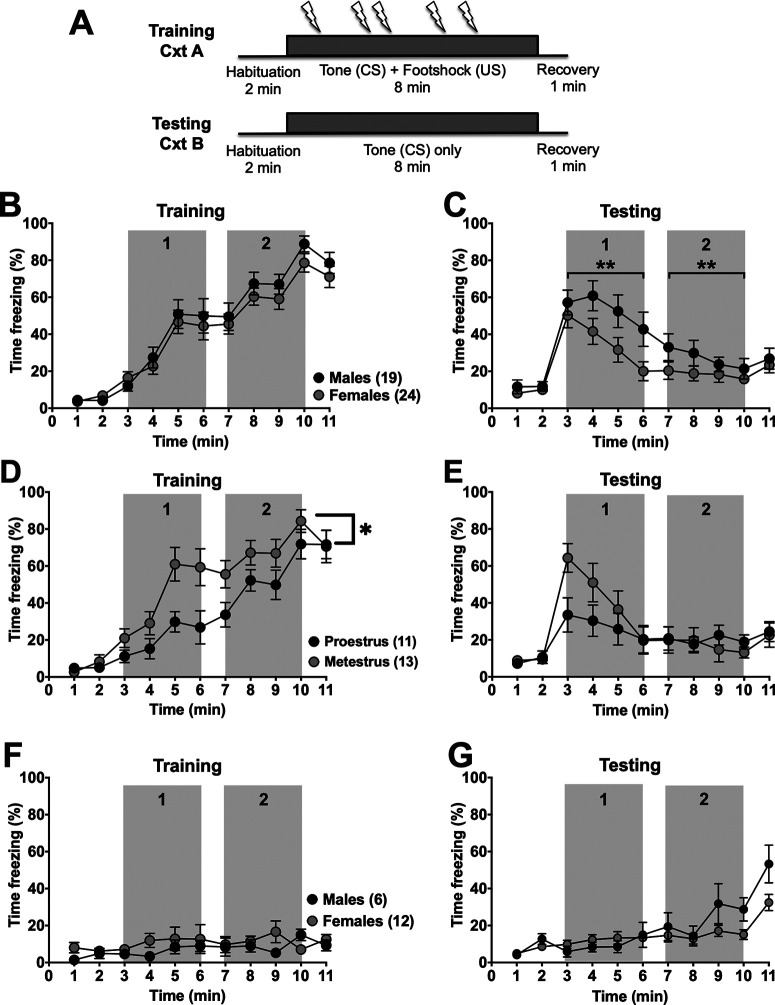Figure 1.
Prolonged cued-conditioned freezing is lower in females compared with males. A, Schematic representation of the prolonged cued fear paradigm where rats are conditioned to the prolonged tone (CS; 5 kHz, 80 dB, 8 min; gray boxes) and receive 5 randomized foot shocks (0.3 mA, 0.5 ms) in context A (Cxt A). Four days later in a separate context (Cxt B), percent time freezing during the CS in the absence of footshocks was tested. B, Percent time spent freezing (1 min bin averages) in naive male (black, N = 19) and female (gray, N = 24) rats during prolonged cued fear conditioning was analyzed, but there was only a significant main effect of time (F(3.705,151.9) = 74.27, p < 0.0001, two-way RM ANOVA) but no main effect of sex (F(1,41) = 0.8288, p = 0.3679, two-way RM ANOVA) nor an interaction between sex and time (F(10,410) = 0.5015, p = 0.8889, two-way RM ANOVA). There were no differences in the total time spent freezing for the first 4 min of the tone (1; t(41) = 1.190, p = 0.21, unpaired t test) and the last 4 min of the tone (2; t(41) = 0.334, p =0.740, unpaired t test) between males and females during prolonged cued fear training. C, During testing, there was a main effect of time (F(3.657,150) = 24.31, p < 0.0001), and a trend for a main effect of sex (F(1,41) = 3.497, p = 0.0687, two-way RM ANOVA), but no significant interaction between time and sex (F(10,410) = 1.613, p = 0.1004, two-way RM ANOVA). Females had significantly lower total time spent freezing during both the first half of the tone (1; t(41) = 3.903, **p = 0.0003, unpaired t test) and second half of the tone (2; t(41) = 5.424, **p < 0.0001, unpaired t test) compared with males during prolonged cued fear testing. Percent time freezing was also calculated and compared by estrous cycle stage (black, N = 11 proestrous; and gray, N = 13 metestrous) and time (D). There were main effects of both time (F(4.376,96.27) = 38.09, p < 0.0001, two-way RM ANOVA) and estrous cycle stage (F(1,22) = 7.127, p = 0.014, two-way RM ANOVA), with all animals spending more time freezing as the experiment progressed, and proestrous females freezing less overall compared with metestrous females. There was also a significant interaction between time and estrous cycle stage (F(10,220) = 1.947, *p = 0.0404, two-way RM ANOVA). E, A significant interaction between time and estrous cycle phase was found during testing (F(10,220) = 2.573, p = 0.0058, two-way RM ANOVA) as proestrous rats froze significantly less than metestrous females during testing. There was also a main effect of time (F(10,220) = 11.44, p < 0.0001, two-way RM ANOVA), but not cycle stage (F(1,22) = 0.4649, p = 0.5024, two-way RM ANOVA) as both groups reduced freezing over time. F, A separate group of male (black, N = 6) and female (gray, N = 12) rats were conditioned to the tone in the absence of footshock. There was no main effect of time (F(3.311,33.11) = 1.224, p = 0.3177, two-way RM ANOVA), sex (F(1,10) = 1.317, p = 0.2779, two-way RM ANOVA), nor interaction between the two (F(10,100) = 1.224, p = 0.2853, two-way RM ANOVA) during training. G, These same rats were then tested in Cxt B to ensure that there were no sex differences in freezing in response to tone alone. While there was no main effect of sex (F(1,16) = 2.274, p = 0.151, two-way RM ANOVA), we did have a main effect of time (F(4.294,68.71) = 15.72, p < 0.0001, two-way RM ANOVA) as rats began to freeze at the end of the experiment. Furthermore, there was also a significant interaction (F(10,160) = 2.548, p = 0.007, two-way RM ANOVA) between time and sex as male rats froze near the end of the experiment more than females.

